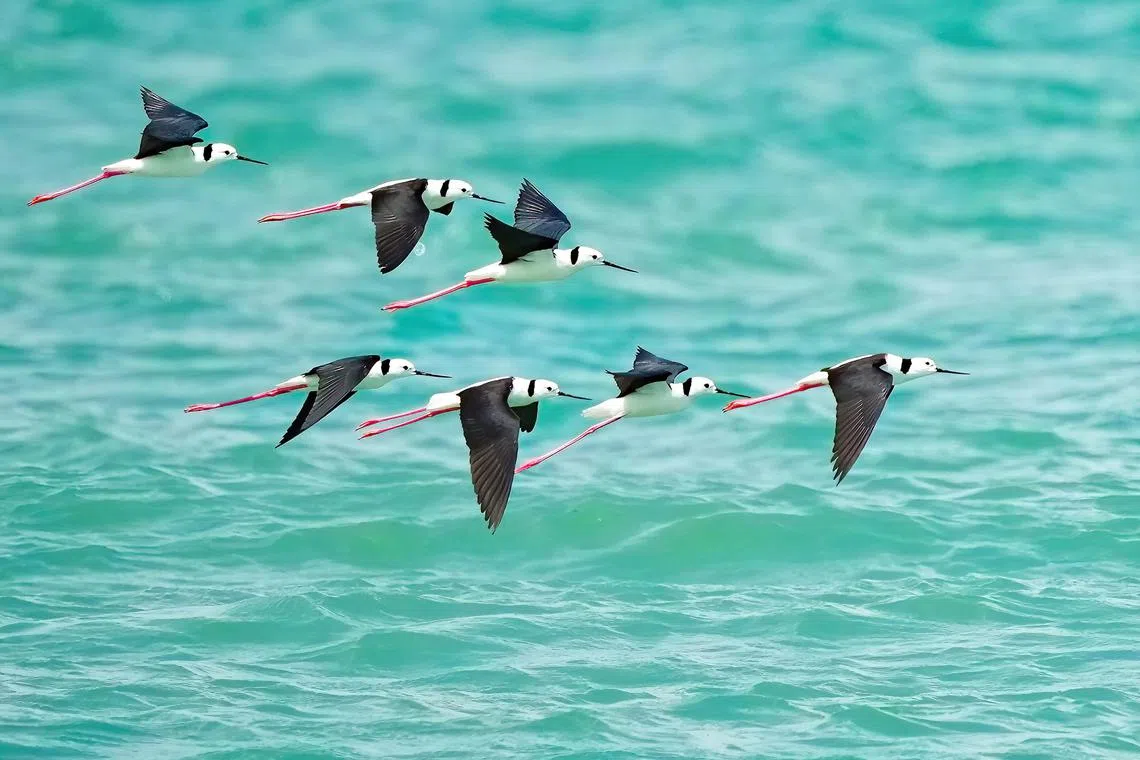Beautiful shorebirds make debut on mainland Singapore
Sign up now: Get ST's newsletters delivered to your inbox

A flock of pied stilts at Marina East Drive on Tuesday at 2.27pm.
PHOTO: ANDY CHEW
Follow topic:
SINGAPORE - Flocks of pied stilts have captivated bird watchers over the past week with their first reported appearances on mainland Singapore.
Since Tuesday, the black-and-white shorebirds, with their pink-stockinged legs, have been photographed in Yishun and Marina East Drive.
Bird enthusiasts told The Straits Times that the birds, which were previously recorded only in Pulau Tekong, are regarded as rare in Singapore.
The stilts (Himantopus leucocephalus), also known as the Australian stilt, were first seen in Singapore on the offshore island in 2019 and, to date, have been recorded thrice there, according to the bird enthusiasts’ initiative Singapore Birds Project.
Bicycle shop owner Dannis Soh first saw the shorebirds on the mainland by chance, when they stood on the shore while he was cycling along Yishun Dam after work on Monday afternoon.
The hobbyist wildlife photographer returned to photograph the group of 14 stilts on Tuesday afternoon.
The 49-year-old said: “I didn’t pay much attention to them (on Monday) as they looked common, and my camera wasn’t with me... More than a day later, I realised that they could be rare after people shared sightings of the birds in Marina East.”
The birds were nowhere in sight when photographers visited the Yishun Dam area to find them on Wednesday, he added.
Separately, seven pied stilts were spotted flying in Marina East Drive on Tuesday.
Although the shorebirds have bred multiple times in Pulau Tekong, the lack of sightings on the main island of the birds, which tend to wander based on weather patterns and food availability, suggests that they are “truly very rare” in Singapore, said the Singapore Birds Project in a statement.
The initiative said several factors can lead to the birds rapidly leaving their territories in search of new areas to forage or even breed in summer.
It said: “One possible example is if a lack of rain dries up the freshwater pools where they usually forage, forcing them to find food elsewhere.”

Several factors can lead to the birds rapidly leaving their territories in search of new areas to forage or even breed in summer.
PHOTO: ANDY CHEW
The recent sightings come as the pied stilts, which are globally plentiful in the wild, have been expanding their range northwards into South-east Asia.
Dr Yong Ding Li, regional coordinator for migratory bird conservation and red listing at BirdLife International, said the stilts have been spreading through south and central Sumatra since the early 2010s.
The clearance of large mangrove forests on the east coast of Sumatra and its satellite islands to make way for fish ponds have attracted the species, which uses these shallow ponds for breeding, said Dr Yong.

Bird enthusiasts told The Straits Times that the birds, which were previously recorded only in Pulau Tekong, are regarded as rare in Singapore.
PHOTO: ANDY CHEW
He said: “The species has therefore colonised such new, emerging habitat from further east, in Java and Bali... In short, the story of the pied stilt is one of man-made landscape change, not climate change necessarily, and an adaptable bird colonising newly created habitat.”
The Singapore Birds Project said the stilts’ spread to South-east Asia is similar to how they landed on New Zealand from Australia around the 19th century.
By the end of the 20th century, the birds’ population in New Zealand was already estimated at 28,000, the group added.

Pied stilts at Yishun Dam on Tuesday at 12.50pm.
PHOTO: DANNIS SOH
Dr Yong said that while it is unclear where the flocks seen this week originated from, the sightings could indicate a potential colonisation of wetlands in mainland Singapore, which has shallow ponds that are suitable for the species.
Should members of the public spot the birds, which are skittish, they should keep a distance and avoid disturbing them, he added.
Additional reporting by Yong Li Xuan


